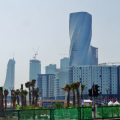530 Million Passengers: Will Middle East Infrastructure Keep Up with Passenger Surge?

There is an unheard-of increase in air travel in the Middle East; 530 million passengers are predicted. Can the infrastructure of the region keep up with this rapid expansion is the question this begs.
Numbers Surge
The aviation industry is growing strongly according to recent statistics, and by 2024 airline profitability in the Middle East is predicted to reach $3.8 billion. Revenue Passenger Kilometres (RPKs) in the area are expected to increase 9.3% annually. This increase in demand for air travel both within the region and to other countries is a result of the region’s growing economy, tourism, and advantageous position as a major international transit hub.
Investing on Infrastructure
By 2040, Middle Eastern airports should have invested over $151 billion in infrastructure development to handle this increase. Modernising buildings, adding cutting-edge technology, and increasing airport capacity will be the goals of this significant investment. Modern baggage handling technology and sophisticated passenger screening systems are two main areas of attention to improve security and efficiency.
Big Projects and Extensions
Over the region, a number of significant projects are under progress. The growing passenger numbers are being addressed by the development of Al Maktoum International Airport in Dubai and the expansion of Dubai International Airport. Similar large-scale investments are being made by Saudi Arabia in the new King Salman International Airport in Riyadh and King Abdulaziz International Airport in Jeddah. These initiatives are meant to boost capacity, enhance the travelling experience, and simplify procedures.
Regional Obstacles
The area has serious problems even with the positive outlook. Stability and expansion of the aviation industry are at danger from geopolitical tensions and conflicts. Further affecting airline profitability and investment capacity are changing oil prices and unstable economic times. To keep growing and retaining its competitive advantage in the international aviation industry, the area must negotiate these challenges.
Coordinating and Managing Airspace
Congestion of the airspace is one of the major problems. There are some of the busiest aviation routes in the world in the Middle East, hence effective air traffic management is necessary. To reduce wait times and improve safety, nations must coordinate and modernise their air traffic control systems.
The economy of the region could benefit greatly from the increase in passenger traffic and the related infrastructural improvements. The industry of aviation promotes trade, tourism, and business travel, therefore stimulating economic growth. The Middle East is expected to be a major contributor to the $30.5 billion net profits of the global aviation industry in 2024.
Creation of Jobs and Development of Skills
The growth of the aviation industry is also expected to bring about a plethora of employment prospects in engineering, building, airport operations and tourism. Meeting the need for a qualified workforce and guaranteeing the region’s long-term economic gains will need funding skill development and training initiatives.
Environmental Factors
The need of reaching net-zero carbon emissions by 2050 to guarantee the sustainability of the aviation sector is developing in tandem with the growth in air travel. To lessen their environmental effect, Middle Eastern airports and airlines are making investments in green technologies, sustainable aviation fuels (SAFs), and more fuel-efficient aircraft.
Keep on Reading
The Future of Sustainable Aviation
Leading the charge in implementing sustainable procedures are a number of Middle Eastern airlines. Etihad Airways and Qatar Airways, for example, are actively involved in programmes to lower carbon footprints and improve operational effectiveness. The region’s larger approach to achieving sustainability goals also includes the construction of solar-powered airports and the utilisation of renewable energy sources.
Synopsis
The infrastructure of aviation in the Middle East is becoming ready to handle the increase in passengers. With significant investments and a concentration on sustainable development, the area is well-positioned to continue being a major hub for aviation worldwide. Long-term success will depend, meanwhile, on resolving geopolitical issues, managing airspace, and environmental issues. The Middle East can keep prospering as a key participant in the international aviation sector by striking a balance between expansion and sustainability.






